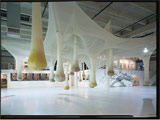
| Interview with Martin Margulies |

Martin Margulies.... Melissa Dubbin: Martin, I have always enjoyed hearing you talk about the works in the collection and the artists who created them. You are truly passionate about your collection. How did you begin collecting contemporary art? Martin Margulies: I began collecting prints and then moved on from there. The first important work I purchased was a sculpture by Isamu Noguchi. That was in 1978. I am very fortunate to have art in my life, which has been a tremendous experience for me. MD: What was your introduction to video and computer-based artworks? Do you recall your first media-based art acquisition? MM: The first video work we bought was a Fischli & Weiss video, Der Lauf der Dinge (1987) It was a VHS videotape that I purchased in Germany maybe fifteen years ago. My two sons were young at the time and we would watch it together on our TV set at home. We have it playing now open to the public at the Warehouse collection and it is consistently the most popular video work we have playing. MD: Were you ever intimidated by collecting video or computer-based artworks? MM: No, never. MD: What processes do you and Katherine employ when it comes to dealing with the acquisition, display and preservation of media based artworks? MM: We concentrate on how a work of video will fit into the collection. We function primarily as an educational facility, so it is exciting to come across work that the students will relate to, like the recent work by Cory Archangel based on a Nintendo game, with a techno music sound track. In terms of the display and presentation, we rely on professional advice from the galleries and our installation team, which advises us on an ongoing basis. It’s important to get the installation right, so we seek the best professional advice in that area. MD: In a NY Times article about the Art Basel Miami Art Fair in 2005, Roberta Smith said that with regards to the installation of works at the warehouse, the ”impassioned indifference to the distinctions between mediums is inspiring.“ Can you and Katherine speak about your approach to exhibiting works in the public part of your collection? MM: The exhibition is anchored by several large-scale major installations that are permanent, such as the Ernesto Neto, Jeff Wall, and Olafur Eliasson, which compliment the demands of space, weight and traffic flow. From there we develop a pace or rhythm to the exhibition. There is one area where we try to present German photography with a historical perspective, but other than that area we try to develop a pacing or rhythm. Our approach is to present entire bodies of work, whole portfolios, and let people come to their own conclusions.. MD: . How much do you follow the guidelines or specifications provided by artists with regards to the way works are installed? MM: We carefully follow artist’s specifications. Often we bring artists to Miami, give them a space, and then stay out of their way. MD: Do you find that some of the works come with technical support, or do you always work with outside staff or technicians to install and maintain these works? MM: We always work with our team of professional installers who are artists themselves. This is very important to us – the artistic point of view. It means we are on the same page and their advice comes from the same point of view. They are sensitive to the interest of the artist but also practical, because the video installations have to fit with over 1,100 other works of art in the building. MD: Have you encountered any issues related to preservation? For example, are there works that you have purchased for which equipment is no longer manufactured or the platform with which the work was created is no longer supported? MM: We have encountered issues in this area. It just takes a tenacious attitude that we are going to keep trying to get this work up and running. We have a Calzolari in the collection that includes refrigerator coils around a mattress. The refrigerator coils are from the 1960’s and use Freon, which is no longer used or readily available. We tracked down the last remaining Freon repairman in Miami who was able to help us. You just keep at it, and when people hear it’s for art they go out of their way to help. They find it interesting that they can use their skill in the name of art. With technology it’s the same thing; you find a way. MD: How do you deal with loans of media based artworks from the collection? MM: We don’t lend equipment unless it is a sculpture element like a Tony Oursler figure. We just send the DVD exhibition copy on loan.. MD: What strategies do you have when insuring and preserving media based artworks such as DVDs, DigiBeta tapes, or items such as Nintendo cartridges for Cory Arcangel’s Super Mario Movie (2005), which is in the collection? MM: Well, we try to get duplicates up front and keep them in an archival file. With Cory’s work we purchased a duplicate Nintendo set and put it in storage. As for the cartridge, we would rely on the artist to step up if something would go wrong. Artists have been very willing to accommodate us. They get feedback on how their pieces wear in a public setting. MD: From your experience, what advice would you give new collectors of media based artworks? MM: Advice we would give is to aspire to the education aspect—get involved with students and make the work available. And also to go back to earlier periods, forge links between the 1900’s and what’s happening now. There is the additional element of the technical—make sure you understand the equipment involved, research carefully and know your space.
|